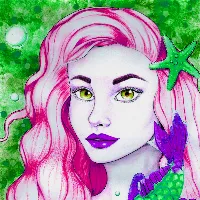One of my favorite pieces of jewelry — and one that I wear very often, too! — is this ruby pendant. It wasn't incredibly expensive, perhaps USD $30, ordered from an individual who makes jewelry and sells it in their online shop. They had a matching pair of earrings which I really wanted, too, but didn't have the money for both. So, I ordered the pendant. When I got my next paycheck, I went back for the earrings, but they had been sold. 😬 I have been so delighted with this pendant, though, so I can't be too sad that I didn't get the earrings, too. 😊
This particular shape is called a cabochon. It is cut flat on the backside and domed on the front side. Gemstones that are opaque are often cut in the cabochon manner, for easy mounting and maximum beauty. Finishing stones en cabochon was the only method available until faceted "gem cutting" was invented. This ruby cabochon is set in a Sterling silver (92.5% silver) setting.

Any corundum that is red is called a ruby, regardless of what shade of red is seen in the stone. And that shade of red can vary greatly from a deep red (like a garnet) to almost pinkish hues. The most prized rubies, however, are red with undertones of blue, which is referred to as "pigeon's blood" red in the ruby trade. The undertones of blue give a faint violet-colored appearance to the red.
One vendor of gemstones (Israel-Diamonds.com) offers an explanation as to why the "pigeon's blood" red color might be considered the best for rubies. When such a ruby is mounted in a setting made of yellow gold, the yellow in the gold plays a visual trick on the eyes by "canelling" the blue undertones in the ruby, making it look a more vivid red color. [source]
I don't know if there is any credence to be lent to that explanation or not, as I am not an expert in the science of color, but it sounds plausible. All of my ruby jewelry is set in sterling silver, since that is what I prefer (and can afford), so I have nothing with which to test that theory.
I do have one cheap little ruby ring, which has cubic zirconias on each side. The ruby itself is small, but pretty and is a delightful stone. The setting is sterling silver (.925). Sadly, the cubic zirconias were not mounted very well and two of them have fallen-out in the 15-or-so years I've had the ring, so I don't wear it any more. I imagine I could get it fixed since cubic zirconias are not terribly expensive.
And, I do have another ruby ring which has a pear-shaped cabochon in it. It feels a bit clunky and heavy when wearing it, though, so I don't wear this one very often, even though the ruby is lovely. The color of the stone isn't quite as exquisite to me as the one in the ruby pendant, but a deeper red.
HOWEVER... feast your eyes on the following gorgeous ruby, the best of all my ruby rings. I simply adore this ring and wear it very often! This ruby is "gem quality" — i.e., translucent rather than opaque, and has relatively few imperfections. There are a couple of dark "spots" down in the ruby which would make a high-end jeweler snort in derision and throw it on the scrap heap. But I think those little spots give the stone a bit of "character" and make it unique, just as our own individual scars make each of us unique beings. And it is only because of those imperfections that I was able to afford this 8.85 carat beauty, otherwise it would have been way out of my price range. The dark spots are easily visible in the photo, below.
This ruby is also in a sterling silver (.925) setting and mounted in a way that allows the most light to enter the stone.
Besides the beauty of the ruby, itself, I was also quite taken by the pattern on the side of the ring. To me, it resembles a Goddess, holding the stone, a very feminine touch which I adore! Can you see the outline of a feminine figure, as I do?
This post, as with Part 1, is dedicated to the charming @silversaver888, my ruby-loving and silver-stacking sister! 💖 Cleavage photo dedicated to @enginewitty 😁
SOURCES 1 Wikipedia: Cabochon 2 Wikipedia: Corundum 3 Wikipedia: Ruby

Citrine Crystal • Amethyst Crystal • Kitty Geode • Phoenix Crystal
Barbeque & Amethysts • Salt Lamps • Trilobite • Arrowhead
Garden Quartz, freeform • Granite Quarry № 2 • Apophyllite
Rocks from Space! • Quartz Rock: Raw versus Polished
Chrysocolla • Tourmaline • Bornite • Goethite • Small Quartz Crystal
Smoky Quartz • Tibetan Quartz • Amazonite Beads • Zoisite
Rutilated Quartz • Garnet • Amazonite Sphere • Lapis Lazuli Mala
Amethyst Point • How Rocks Get Their Color • Red Jasper
Ring, Ring! Amethyst Calling! • Lapis Lazuli • Turitella Agate


 to learn more about either of these projects, please visit: @heyhaveyamet or @steemterminal
to learn more about either of these projects, please visit: @heyhaveyamet or @steemterminal04-Dec-2019
Return from Ruby – Part 2: Jewelry to 𝕜𝕚𝕥𝕥𝕪's Web3 Blog

